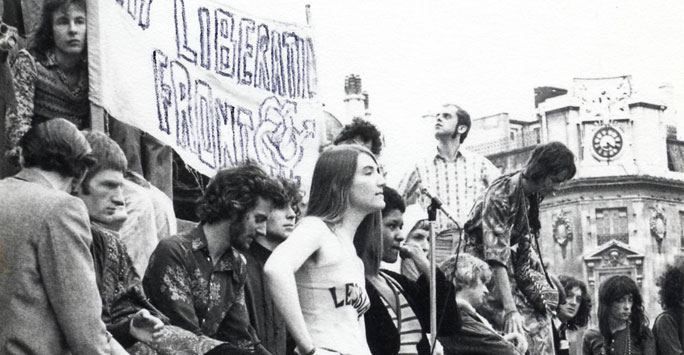
The Gay Liberation Front (GLF) originated in America, with the famous Stonewall Riots on 27 June 1969 and leading figures such as Marsha P. Johnson and Sylvia Rivera. By 1970, the idea had been brought over to the London School of Economics and the first meeting was held in a basement with 19 people on the 13 October 1970. Within a month, after leafleting and more meetings, the crowds of attendees grew.
The movement had grown to 200 attendees by November 1970, adding publications such as Gay News and Come Together and starting to hold ‘gay days’. Other branches of the GLF started popping up across the country, especially in Manchester and Brighton.
The GLF Manifesto was published in 1971. It had radical demands. The lengthy manifesto outlined 10 ways that gay people were oppressed, including in school, employment, the family, law, and self-oppression. Their aims were radical, wanting to abolish the family unit and cultural distinctions between men and women, aiming to end the sexist supremacy of the straight man. They shared a lot of solidarity with feminist movements and believed an end to straight male supremacy would benefit both women and the gay community. They wanted communal living and argued against reform, saying it would not go far enough.
The GLF never gained its demands, and the movement had splintered by 1973. Splits first appeared in 1971, with ideological disputes over socialist revolutionaries who put sexism and sexuality first, then radical lesbian feminists against male chauvinists and single issue gay civil rights men.
Just because the GLF split, did not mean everyone called it a day. New initiatives and new groups formed such as 'Icebreakers', a gay befriending network that allowed gay men to come out and learn about activism, and 'Switchboard', which still provides support to LGBTQ+ community over the phone today. In the early years of the AIDS crisis, Switchboard provided support before many joined a separate National AIDS helpline when the gravity of the crisis sunk in.
'Gay News' was formed in 1972, many publications followed and a gay publishing house was created; the Gay Men’s Press in 1979. Without the GLF, but there would not have been such strong community support for people with AIDS at this time. By the 1980s, the organisations, support and activism of the GLF had created a foundation for the queer community to fight the AIDS crisis and in the 1990s many queer organisations such as Stonewall and Outrage had GLF activists involved and leading these newer groups.
Another legacy of the GLF is that some people have moved into non-gay organisations. Being out and proud, they felt they could do so again. The Sexual Offences Act was only passed in 1967, which legalised some (not all) homosexual acts - it had to be between two men, in private, consensual and over 21. At the time the GFL emerged, coming out was still very much a big deal. The GLF had made people feel more confident about coming out and being openly gay.
The GLF had been a radical organisation, calling for communal living and the abolition of family and stood up for the rights and opposed capitalism. In 1995 Pride, on the 25th anniversary of the founding of GLF, members spoke of how the gay liberation movement had been subverted into gay capitalism.
Stuart Feather (participant of GLF street theatre group and the GLF) spoke of how gay people had found their voices but had left the socialist ideas behind.
25 years on, it could be argued that this is still the case. Pride marches are now Pride parades sponsored by Barclays, feeling more like an advertisement than a protest.
Timothy Thompson is a third year undergraduate history student.
Discover more
Find out more about studying history at Liverpool.